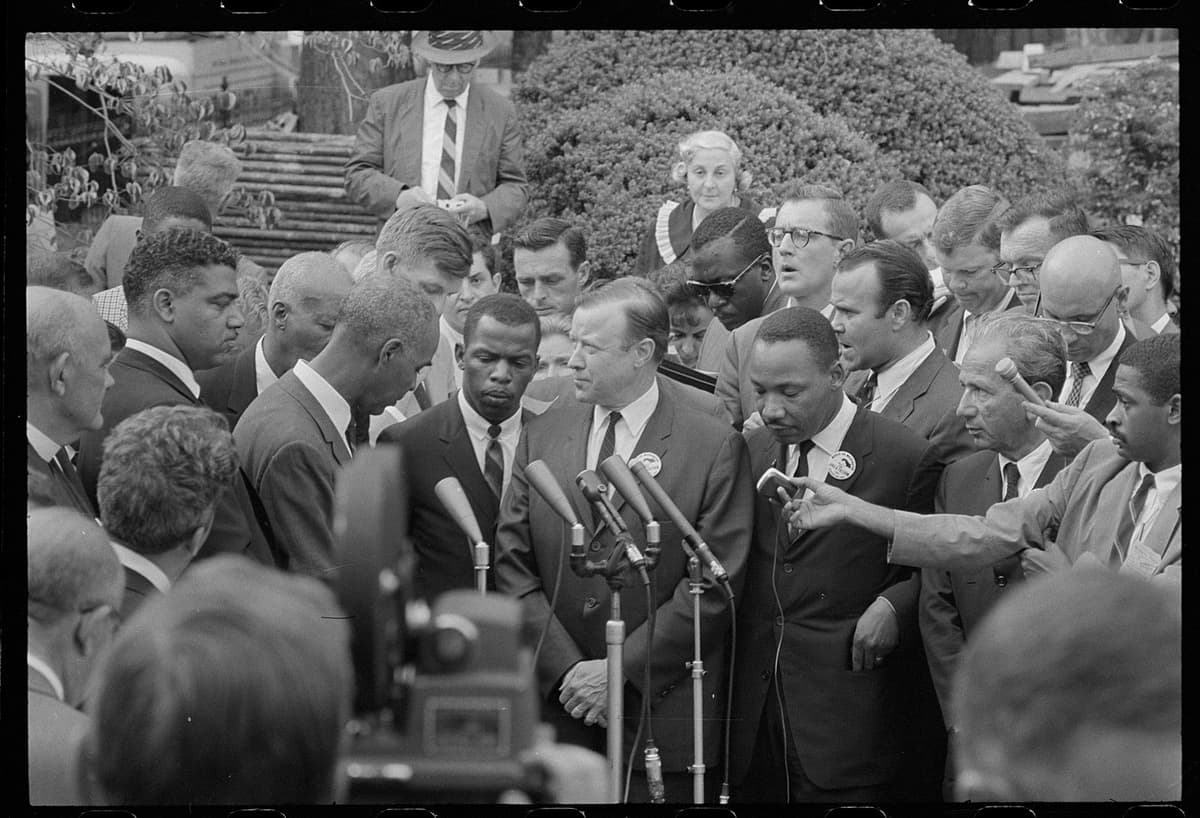The Radically Different Lives of Martin Luther King Jr. and John Lewis
Lewis’s vulnerability disarms his biographer, whereas King for all his noble rhetoric and moral suasion had a crass side that permits a biographer to be a little more earthy than this one.

‘King: A Life’
By Jonathan Eig
Farrar, Straus and Giroux, 688 pages
‘John Lewis: In Search of the Beloved Community’
By Raymond Arsenault
Yale University Press, 588 pages
John Lewis first shows up in Jonathan Eig’s trenchant biography as the kind of courageous and determined civil rights activist that Martin Luther King Jr., a brilliant preacher but no organizer, depended on.
Lewis suffered blows that boxer Muhammad Ali, one of Mr. Eig’s other subjects, never had to endure — such as getting hit on the head with a Coca-Cola crate aboard a Freedom Riders bus protesting segregation. Raymond Arsenault continues the story, describing Lewis as he went down, his knees collapsing, everything turning white, then black, as he lost consciousness.
Lewis sometimes took a harsher tone than King, wary of the Kennedy administration’s effort to mollify civil rights protestors; King, in Mr Eig’s account of the March on Washington, surveyed the gathering of something like 250,000 people and approached the podium with a slight smile, even as those closest to him watched for anyone who looked suspicious.
While Lewis and other radical figures like Malcolm X advocated militant action, King, in Mr. Eig’s words, “saw strength in restraint,” which gave the white supremacists no cause to cast civil rights leaders as aggressive.
Mr. Eig announces that he “seeks to recover the real man from the gray mist of hagiography: canonized by the “I Have a Dream” speech. The biographer credits King with bringing the nation “closer than it had ever been to reckoning with the reality of having treated people as property and secondary citizens,” but he also wants to recall the man who “chewed his fingernails, twice attempted suicide as an adolescent, depended on his wife Coretta and cheated on her compulsively.”
Mr. Arsenault begins his biography in a different realm from King’s — not in urban Alabama as a preacher’s son, but in the state’s cotton fields, in a “static rural society seemingly impervious to change and mobility.”
More than other civil rights leaders, Lewis ended up behind bars with a “bandage on his head,” as Mr. Arsenault reports. Lewis believed that a leader had to be blooded to “help redeem the soul of America.” Yet he never turned bitter, no matter how militant he might sound. He went beyond King in forays into the political system, so that, in Mr. Arsenault’s words, he “won recognition as ‘the conscience of Congress.’”
Mr. Arsenault ranks Lewis with a “small number of other transcendent historical figures — Martin Luther King Jr., Frederick Douglass, and Harriet Tubman” — an appropriate assemblage since Lewis grew up in the Black Belt, not that far distant from the enslavement that Tubman and Douglass escaped and excoriated.
It is less likely that Lewis would have developed so quickly as a leader without King, whose words, Lewis said, set him on fire, articulating “everything I’d been feeling and fighting to figure out for years.”
How biographies present their subjects depends not only on style and structure but on what can be known about the subject and the subject’s conduct. While Mr. Arsenault desires to get at Lewis’s private experiences, the biographer’s approach seems a little tender — not surprising since Lewis inspired extraordinary sensitivity in those he met and worked with.
Lewis’s vulnerability disarms his biographer, whereas King for all his noble rhetoric and moral suasion had a crass side that permits a biographer to be a little more earthy than Mr. Arsenault, who acknowledges the strain of telling an admirable man’s story while avoiding, he says, “hero worship.”
Mr. Arsenault has written a biography that has quite a different feel from Mr. Eig’s, since Mr. Arsenault enjoyed a 20-year friendship with his subject, and in that time did not see a dark side that went beyond what he calls “mistakes and misjudgments.” If the biographer comes close to hagiography — in spite of protestations to the contrary — it may be because this is the subject he had to work with, open-minded and assertive, but also just shy enough to make it difficult to find any significant fault with him.
Mr. Rollyson is the author of “A Higher Form of Cannibalism? Adventures in the Art and Politics of Biography.”

